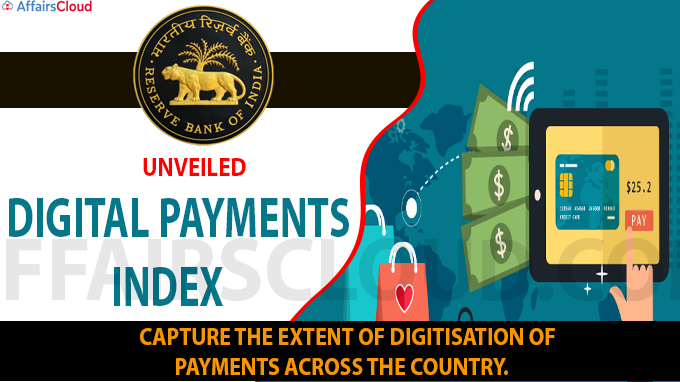 On January 1, 2021, the Reserve Bank of India (RBI) introduced the RBI-Digital Payments Index (DPI) to measure a growth in digital or cashless transactions across the country. It was released on the lines of the Statement on Developmental and Regulatory Policies as part of the Sixth Bi-monthly Monetary Policy Statement for 2019-20 dated February 06, 2020.
On January 1, 2021, the Reserve Bank of India (RBI) introduced the RBI-Digital Payments Index (DPI) to measure a growth in digital or cashless transactions across the country. It was released on the lines of the Statement on Developmental and Regulatory Policies as part of the Sixth Bi-monthly Monetary Policy Statement for 2019-20 dated February 06, 2020.
Key Takeaways of RBI-DPI:
- For the index, the RBI has set the base year 2018, i.e. DPI score for March 2018 is set at 100.
- The DPI for March 2019 was 153.47 while for March 2020 it scored 207.84, representing growth.
- From March 2021, RBI will publish this DPI on its website on a semi-annual basis.
Parameters of RBI-DPI:
It comprises of the following 5 broad parameters:
- Payment Enablers (25%)
- Payment Infrastructure – Demand-side factors (10%)
- Payment Infrastructure – Supply-side factors (15%)
- Payment Performance (45%)
- Consumer Centricity (5%)
Each of the above parameters has sub-parameters which, in turn, consist of various measurable indicators.
Key Points:
–There was an increase in digital transactions in November 2020 including both wholesale and retail transactions.
–The growth in the value of NEFT transactions in November 2020 (27.9%) was higher than that recorded in October 2020 (20.1%).
–In the retail segment, national electronic funds transfer (NEFT) transactions volume grew 24.6 percent y-o-y in November 2020, much higher than the growth (13.9 percent) recorded in October 2020.
–In December 2020, there were Rs 3.9 lakh crore Unified Payments Interface (UPI) transactions while Immediate Payment Service (IMPS) transactions was of Rs 2.76 lakh crore, RTGS transactions was worth Rs 79.8 lakh crore and NEFT was worth Rs 22.18 lakh crore.
–UPI transactions surged to approximately 2.2 billion in November 2020, maintaining momentum in both volume and value terms.
–In the wholesale segment, real-time gross settlement (RTGS) transactions recorded acceleration in volume terms.
–Among other digital transaction modes, national electronic toll collection (NETC) held on to a buoyant growth trajectory and immediate payment service (IMPS) showed stronger growth in November 2020 than October 2020.
Note –RBI had made RTGS available round the clock on all days from 12.30 AM.
–The RBI and government have been pushing for digital transactions over the years to bring in more transparency and efficiency in the financial system.
Recent Related News:
i.Credit Information Company TransUnion CIBIL has partnered with the Ministry of Statistics and Programme Implementation (MoSPI) to launch the First Edition of the Quarterly MSME Credit Health Index. The index will provide a reliable measure and benchmark of the growth and strength of MSME (Micro, Small & Medium Enterprises) in India.
ii.In accordance with the government data, the Consumer Price Index (CPI) rises to 7.61% in October 2020 as compared to 7.27% in the previous month of September, 2020. It was 4.62 % in October 2019. On the other hand, Consumer Food Price Index (CFPI) rose to 11.07% in October, 2020 up from 10.68 % in September, 2020.
About Reserve Bank of India (RBI):
Formation– 1 April 1935
Governor– Shaktikanta Das
Headquarters– Mumbai, Maharashtra
Deputy Governors– 4 (Bibhu Prasad Kanungo, Mahesh Kumar Jain, Michael Debabrata Patra, and M Rajeswar Rao)




